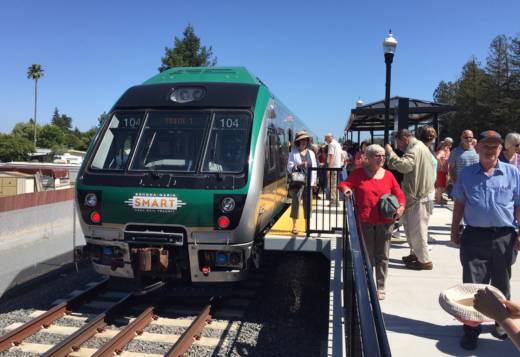“The story is not that complicated,” said Arnold, who has opposed the rail system since its inception and fought the successful sales tax measure funding the transit agency in 2008. He pointed to federal government data that shows SMART, which has about 3,000 riders per weekday, spends about $37.60 for each passenger trip. That compares to $5 per trip for BART.
“It’s an incredible amount to be spending on something that doesn’t deliver very much,” Arnold said.
Over the last two months, the battle over the sales tax extension became the most expensive ballot measure campaign in North Bay history. With a total of more than $3 million spent on the issue, Measure I was also by far the costliest 2020 local ballot fight anywhere in the Bay Area, with a total more than five times higher than the No. 2 big-dollar race, Danville’s Measure Y development proposition.
Sonoma County developer Molly Gallaher Flater donated nearly $2 million to fund the effort to defeat the SMART measure, campaign finance records show. The measure’s supporters raised more than $1.1 million, with about 90% of that cash coming from the Native American tribe that owns the Graton Casino in Rohnert Park.
The Measure I result is not the end of the SMART rail story. The current quarter-cent sales tax that funds the system runs through March 2029, and the agency will have to go to voters before then to get the levy extended.
NotSoSMART’s Mike Arnold said the vote should be a wake-up call for the agency’s appointed 12-member board, made up mostly of Marin and Sonoma elected officials. He argued that the board has failed to rein in “incredibly risky” operating decisions made by SMART managers. He and other opponents have accused SMART of not being transparent about how the agency is run, noting, for instance, that it only recently began releasing ridership reports.
“It’s going to require quite a reform of the agency for them to win back the trust of the voters,” Arnold said. One step in that direction would be to dismiss General Manager Farhad Mansourian, whose leadership SMART opponents have long criticized.
“There were a lot of accusations leveled against SMART, some more factual than others,” said Chris Rogers, a SMART board member and Santa Rosa City Council member. He acknowledged that the board must make strides to become more transparent and to demonstrate to voters that it’s in control of SMART’s budget.
“There were accusations we have no oversight over agency funding,” Rogers noted. “That’s categorically untrue. We need to do a better job of showing what that oversight is.”
Tuesday’s vote “doesn’t change the need for us to get people out of single occupancy vehicles and do a better job of explaining why SMART is something we need,” Rogers said.
Eric Lucan, a member of the Novato City Council now serving as the SMART board chair, argued as the first votes were being counted that SMART is on track to providing an effective commute service — citing, for instance, newly released data that shows weekday ridership in the first two months of 2020 rising about 30% compared to the previous year.
But he conceded that the agency has work to do to win wider public support.
“As a young agency, we’re always collecting feedback and trying to deliver the best possible service we can,” Lucan told KQED’s Mina Kim in an on-air interview.
North Bay voters approved the quarter-cent SMART sales tax in November 2008 by a vote of 69.6% yes. Strong support in Sonoma County, where Measure Q won a 73.7% yes vote, was decisive.
NotSoSMART’s Arnold said that the rail project’s opponents lacked funds in 2008 to mount a campaign in Sonoma County, which in 2008 had about 70,000 more voters than Marin.
He said that the $2 million war chest provided by Molly Gallaher Flater allowed the “No on I” forces to target Sonoma voters this time around. Returns showed Measure I with notably less support in Sonoma County than in Marin County.
Measure Q in 2008 envisioned a roughly 70-mile rail system that would include at least 14 stations and stretch from Cloverdale, at the northern edge of Sonoma County, to the Marin County town of Larkspur. The plan also included a cycling and pedestrian path that would parallel the rail line.

